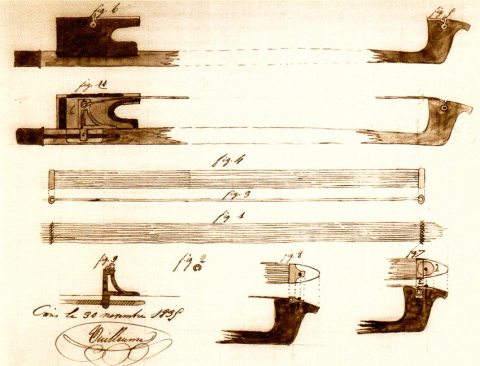VUILLAUME, PAJEOT AND INDUSTRIAL SPYINGI know, I know; it seems like the title of a Donald Duck. If you think about the characters and the dynamics, you might say that more than industrial spying, it seems like a venturous dispute between the machiavellian Scrooge Mcduck and his all time rival Rockerduck. The story finish up as always; Pajeot had to eat his bowler. Selfrehairing bow by Pierre Simon for Jean Baptiste Vuillaume 1850 cc. Ones again I must thank the “Cité de la musique”, for the beautiful photo archive “Musée de la musique”, where I have found the photos I have used for this post. You can visit the web side on: http://mediatheque.cite-musique.fr/masc/ The industrial spying I am referring to is of course the matter between Jean Baptiste Vuillaume, who had patented the selfhairing bow in 1936, and Etienne Pajeot, who sustained that the idea was his and that it had been stolen. Claude Joseph Fonclause moved to Paris, in 1830, to work for Vuillaume. Fonclause had been working at Pajeot for 15 years and in exactly in those years Pajeot was working on the selfrehairing bow. You could be tempted to believe that Claude Joseph Fonclause pasted this secret on to his new Master, as Vuillaume was the first to patent the idea. Even if the accuses Pajeot did towards Vuillaume was founded, I believe Vuillaume deserves a great part of the credit of this innovation because he managed to engineer the project as the first one.
The Vuillaume project of the selfrehairing bow (click to enlarge) This is a classic example of; the one who has a good idea often isn't capable to develop it to its best. Pajeot was a craftsman I admire a lot, so much that he is third on my hypothetical podium, just after F.X. Tourte and J.P.M. Persoit. He was a bow maker with exceptional capacities, but even so he never managed to reach a model at the level of the Vuillaume. You must remember that this last one lived in a town which was known as a primate in mathematics and scientific research in Europe along with Göttingen. In Paris, at the time, there were schools of the highest order such as L'École Polytechnique or the Sorbona and brains as Laplace or Fourier , who gave fundamental input to the world as we know it today. Thanks to the discovery of the Fourier Transform, which is the basis of coding digital signals, we are now able to listen to music from our ipod, and at the time being the light bulb didn't even exist. It was easy to find a good technician for advise in Paris. I imagine that the cultural level at Mirecourt was slightly lower and could therefore be the reason to why the model by Pajeot didn't come out perfect. Anyhow, the model by Vuillaume was surely superior and thanks to the Cité de la musique I can illustrate the functioning of it. The question to resolve was how to give the possibility to the musician to replace the horsehair on the bow by himself. To do this it was needed to deliver the bunch of horse hair ready to be fitted. The idea of Pajeot was perfect, as for the horsehair, the bow head and the realisation of the project. He used a small cylinder in each end of the bunch of horsehair to keep it combed and in place. The cylinder is then inserted in the bow head through a hole on the side. The front part of the mortice remains open on both sides to leave space to pass the horsehair. Often a small excavation is made on the ivory tip with the width of the bunch of the horsehair to prevent it from sliding out over the edge. Until this point all credit goes to Pajeot. The frog though is somewhat more serious, and right here Vuillaume wins. Whereas a hole on the bow head did the trick, the work on the frog required some research so that anyone could dismount and mount it all again. The solution Vuillaume found is extremely elegant. The frog isn't movable on this particular model and the tension of the horse hair is left to the small sail which in one end has a hole that holds the bunch of horse hair and in the other end has a nut. When you turn the screw of the button the structure slides backwards and the horse hair is hold in tension. Ones the bunch was replaced, a small plinth, with the slide made of mother of pearl, was inserted so that it wedged beneath the silver of the knee. At this point it was shut interlocking with the ring and the bow was ready to play. Selfhairing bow by Pierre Simon for Jean Baptiste Vuillaume 1850 cc. (click to enlarge) Replace the horse hair in this way sure wasn't the best way to do it, but it did allow fresh horse hair in every occasion and thinking of the transport possibility at the time, I believe it must have been great help to the musicians. I believe both of them should have the credit for this invention, even though the good Pajeot/Rockerduck ended up eating his bowler while Vuillaume/Scrooge Mcduck enjoyed the scene. So long, Paolo To read more about this topic: ETIENNE PAJEOT; THE THOUSAND HEADED BOW MAKER CLAUDE JOSEPH FONCLAUSE; THE NICE
|
   |






